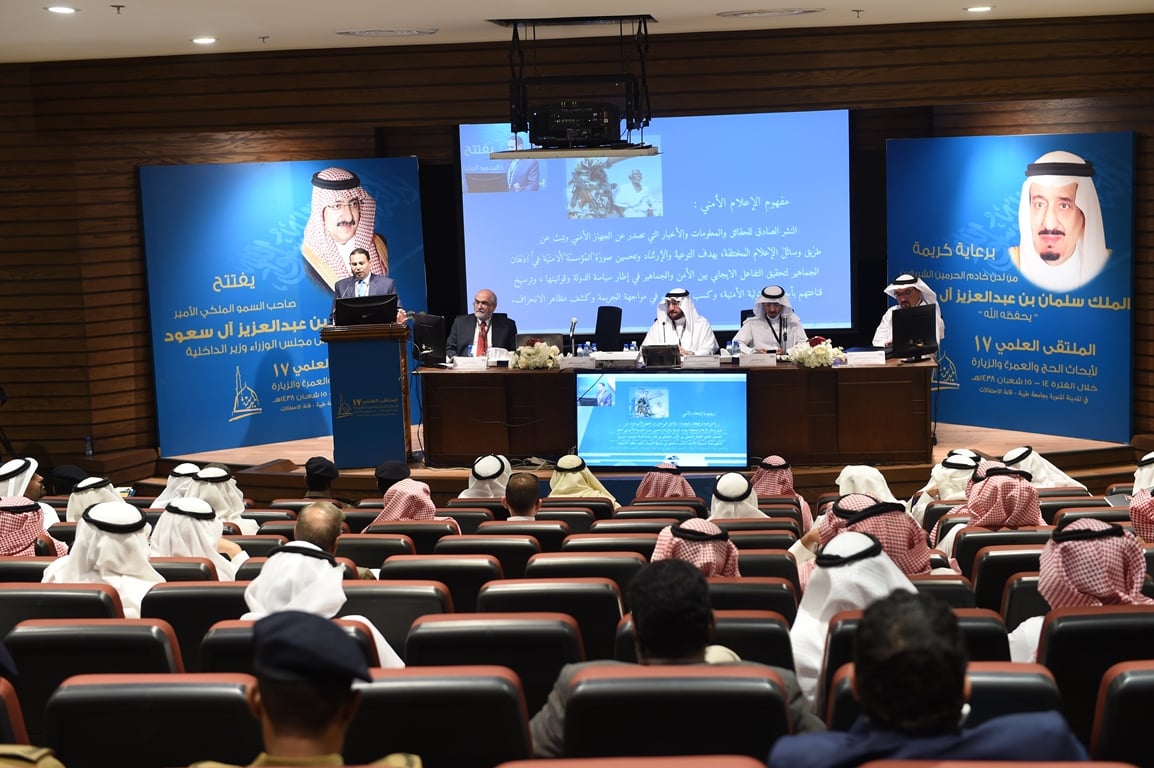
During the second scientific session titled, "Awareness and Media" and headed by Dr. Abdulaziz Bin Gabilan Alsarani (President of Taibah University), the participants in the 17th Hajj and Umrah Researches Scientific Meeting demanded that the media should convey the true image of the services provided and efforts exerted for the comfort and safety of the pilgrims and counter the malicious campaigns directed against KSA. The participants also discussed a number of current media issues. At the beginning of the session, Dr. Abdullah bin Muhammad Al-Wazzan from Northern Boarder University presented a scientific paper titled, "The Role of Twitter in Raising Environmental Awareness among Saudi University Youth." Through the paper, Dr. Al-Wazzan proved the dire need to reinforce environmental awareness widely. This would be via holding seminars, lectures and specialized theoretical and practical courses in universities and both governmental and private civil society institutions, to identify the environment and its seriousness on human beings, and introduce how students obtained an environmental awareness of the environment in which they lived.
Dr. Al-Wazzan called on Twitter officials to encourage users and draw their attention from time to time to publish everything related to the environment and its impact on humans. This would lead to the formation of environmental awareness inside users, especially all those who deal with news, comments, photos and videos about the environment.
On the other hand, Dr. Iman Fathy Abdulmohsen from the College of Social Sciences at Umm Al-Qura University (UQU) demonstrated a scientific paper titled, "The effectiveness of an electronic guidance application on smart phones in the awareness of visitors to the Prophet's Mosque in Religious Tourism in Medina - a survey." Through the paper, Dr. Abdulmohsen concluded that there was consensus on the development of an electronic guidance application in this regard. Moreover, she noted that Al-Baqi was at the forefront of the religious tourism sites visited by the study sample in Madinah, followed by Jabal Uhud and the Green Dome Mosque respectively.
In this context, Dr. Abdulmohsen drew attention to the lack of knowledge of many visitors to the Prophet's Mosque of much of those tourist places. Therefore, she called for the utilization of the new media and its various applications in tourism awareness, in order to achieve the objectives of KSA Vision 2030, including taking care of and raising awareness about the tourism sector.
Within the same vein, both Dr. Wagdy Helmi Abdel-Zaher and Dr. Mohamed Ali Gharib from the College of Social Sciences at UQU participated with a work sheet titled, "The Role of Security Media in Supporting the Image of KSA to Pilgrims and in Addressing the Media Campaigns Directed from Abroad." The paper stressed the significance of the role played by security media to counter the tendentious propaganda campaigns broadcast from abroad, and its impact on achieving the stability, security and safety of pilgrims during the Hajj season, and enabling them to perform their religious rituals to the fullest. The two staff members noted that it was necessary to monitor the interactive relationship between the Saudi security media and the degree of pilgrims' satisfaction and confidence in what it offers to support and strengthen the religious message and security services targeted by the media directed at distorting the image of the Kingdom, which should be countered. They also said that security media raised awareness against the dangers of such external interventions and maintained the security and safety of pilgrims.
They also pointed to the role of security media in bringing the media and security closer together, conveying the security information, providing recipients with security knowledge and information, allowing full knowledge of security issues away from the concealment of information, and advising the community regarding procedures to protect lives and public and private properties, to prevent citizens from falling into crime and to intimidate the consequences of crime commission.
Within the same framework, Eng. Abdullah Muhammad Fouda, Dr. Fadhel Muhammad Othman, Dr. Othman Bakr Qazzaz, Dr. Ahmad Hatem Qadhi and Eng. Farouq Muhammad Taher from the Custodian of the Two Holy Mosques Institute for Hajj and Umrah Research, UQU participated with a work sheet titled, "Study of the Most Effective Forms and Symbols in the Prophet's Mosque." The group concluded that it was significant to unify the general shape of the guiding signs, highlight the identity of Madinah in its design and the application thereof to symbols related to important places such as places of prayer and places of drinking Zamzam water. They pointed out to the significance of the statement of information codes, communication with persons with hearing disabilities, and the services of religion, baggage and missing things, food and drink, security and health, bathing and ablution places, obstruction symbols, vertical movement, elevators and safety and emergency codes, as well as the development of the rest of guiding symbols.
In turn, Dr. Fahd Abdulkarim Turkistani, Associate Professor of Physical Chemistry at UQU, participated with a work sheet titled "Comprehensive Environmental Clinic Program." Through the sheet, Dr. Turkistani called for the development of sound environmental management principles for the protection and implementation of the internal environment and its surroundings. This would be achieved through programs based on developed and modern scientific foundations, consistent with the detection of new pollutants via the so-called "Environmental Clinic" and its environmental consultant. This was with the aim of identifying the environmental polluter of the causes of health problems after the scientific vision of reality, and providing appropriate solutions to remove such causes of the resulting diseases.